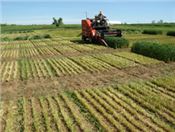|
Wheat Varietal Differences In Forage Yield Potential

BILL BRUENING
LEXINGTON, KY.
Wheat is an important source of forage for many growers/livestock producers. Approximately 20 percent of Kentucky’s annual wheat acreage is not harvested for grain, and much of that acreage is utilized for forage production. One advantage of utilizing wheat for silage, green-chop, or hay production is that wheat forage production can be double-cropped with corn or full season soybeans. Additionally, wheat provides a reliable source of quality forage in the spring when other fall/summer sources are low in quantity and/or have deteriorated in quality. Wheat’s potential for producing quality forage also allows growers some flexibility in crop utilization. Many acres are planted specifically for forage or grain production, but factors such as grain prices, forage supply/prices and crop condition (i.e. freeze damage) may affect end-use decisions based on potential profitability.
The time to harvest wheat forage is an important decision. Harvest timing is often dependent on if the crop is part of a double-crop system, weather conditions, labor/equipment issues, and the end use requirements of the crop (high quality forage [dairy] or greater yields of average quality haylage). A wheat silage crop for dairy forage should be cut at the late boot stage. At this stage the levels of energy, protein content and digestibility are high (similar to corn silage or alfalfa haylage). It is possible to double-crop with corn when harvested at this stage.
It is more common in Kentucky to harvest at later stages of development (up to the soft-dough stage). Biomass yields increase throughout the reproductive growth period, but the quality also declines throughout this period. Wheat cut at mid-dough stage produces what is considered average quality hay. Fiber content is higher and digestibility and protein are lower, but dry matter tonnage will be 30-60 percent greater than silage cut at the boot stage. Though not necessary, it is recommended for palatability purposes, that awnless (smooth) head type varieties be used if harvesting at this latter stage.
The University of Kentucky Small Grain Variety Testing Program evaluates wheat varieties for differences in forage yield potential. The tests are harvested at the soft-dough stage with a small plot forage research combine and results reported as tons dry matter per acre. Yields are listed for the current year’s test, as well as the 2 and 3 year averages. In 2018, yields averaged 3.36 and ranged from 2.66 - 4.20 tons per acre. In 2017, yields averaged 4.14 and ranged from 3.36 – 4.85 tons per acre, showing the dramatic differences in forage yield potential among wheat varieties. Due to natural variability of data from a single test, it is recommended that results from the 2 or 3 year average column be used for variety selection. The UK wheat forage variety test results table also lists the head type (smooth vs bearded) for each variety tested.
Forage yields vary widely among wheat varieties. UK variety test data on forage yield potential are available at www.uky.edu/ag/WheatVarietyTest. For additional information, see AGR-160 Managing Small Grains for Livestock Forage, also available at the fore mentioned website. ∆
BILL BRUENING: Research Specialist, University of Kentucky
|
|